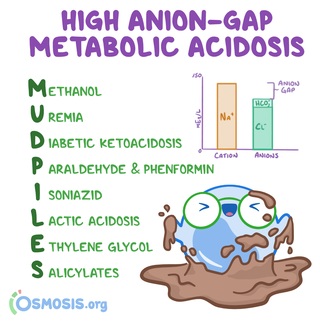Mastering Anion Gap Metabolic Acidosis Causes with a Simple Mnemonic Technique ![]()
Greetings, medicos! 🙂 Today, in this article, we’re delving into an important topic in the realm of basic medical sciences: Anion Gap Metabolic Acidosis Causes. As you embark on this enlightening journey to become well-rounded medical students and competent physicians, understanding this condition is crucial. To aid you in your journey for knowledge, I’ve brought you two ingenious mnemonic techniques that will not only make memorizing the causes of Anion Gap Metabolic Acidosis crystal easy but also ensure they stick with you for many years to come.
In this engaging lesson, we’ll dissect the complexities of Anion Gap Metabolic Acidosis, breaking down the science behind it into easy-to-digest facts. So, let’s dive in and decipher this medical mystery together so that you are confident in your med-school exams and hospital ward rounds!
Causes of Anion Gap Metabolic Acidosis Mnemonic
One of the most common medical mnemonics to learn the anion gap metabolic acidosis causes is “MUDPILES”.

MUDPILES
Let’s break down the mnemonic for a moment of clarity:
- M – Methanol
- U – Uremia
- D – Diabetic ketoacidosis
- P – Propylene Glycol
- I – Isoniazid
- L – Lactic Acidosis
- E – Ethylene Glycol
- S – Salicylates
GOLD MARK
There is another innovative anion gap metabolic acidosis mnemonic, aptly named “GOLD MARK,” stems from a 2008 article in The Lancet.
Breaking down the updated mnemonic:
- G – Glycols (ethylene glycol and propylene glycol)
- O – Oxoproline
- L – L-Lactate
- D – D-Lactate
- M – Methanol
- A – Aspirin
- R – Renal Failure
- K – Ketoacidosis
We hope that you find this mnemonic useful in memorizing the causes of anion gap metabolic acidosis. Happy learning, folks! 🙂
Bonus: Equation to calculate the anion gap
Wondering how to calculate the anion gap using a formula?

Fear not as we got you covered here! 🙂
Here’s the simple equation/formula to calculate the anion gap:
Anion Gap = (Na+ + K+) – (Cl- + HCO3-)

![Causes of Anion Gap Metabolic Acidosis Mnemonic [MUDPILES + GOLDMARK]](https://www.medicosrepublic.com/wp-content/uploads/2023/08/Causes-of-Anion-Gap-Metabolic-Acidosis-Mnemonic-MUDPILES-GOLDMARK-696x391.jpg)



![Carcinoid Syndrome Mnemonic [Easy-to-memorize] Carcinoid Syndrome Mnemonic](https://www.medicosrepublic.com/wp-content/uploads/2024/08/Carcinoid-Syndrome-Mnemonic-Easy-to-memorize-218x150.jpg)

![Stages of Neurocysticercosis Mnemonic [Vegans Can’t Get Neurocysticercosis] Stages of Neurocysticercosis Mnemonic](https://www.medicosrepublic.com/wp-content/uploads/2023/08/Stages-of-Neurocysticercosis-Mnemonic-Vegans-Cant-Get-Neurocysticercosis-1-218x150.jpg)
![Kumar and Clark’s Clinical Medicine 9th Edition PDF Free Download [Direct Link]](https://www.medicosrepublic.com/wp-content/uploads/2018/08/Kumar-and-Clark’s-Clinical-Medicine-9th-Edition-PDF-Free-Download-150x150.jpg)
![Neuroglia 3rd Edition PDF Free Download [Direct Link] Neuroglia 3rd Edition PDF](https://www.medicosrepublic.com/wp-content/uploads/2022/11/Neuroglia-3rd-Edition-PDF-Free-Download-150x150.jpg)
![MRCP Part 2 450 BOFs (Best of Five Questions) PDF Free Download [Direct Link]](https://www.medicosrepublic.com/wp-content/uploads/2017/09/MRCP-Part-2-450-BOFs-Best-of-Five-Questions-PDF-Free-Download-150x150.jpg)
![Internal Organs (THIEME Atlas of Anatomy) PDF Free Download [Direct Link] Internal Organs (THIEME Atlas of Anatomy) PDF](https://www.medicosrepublic.com/wp-content/uploads/2019/03/Internal-Organs-THIEME-Atlas-of-Anatomy-PDF-Free-Download-150x150.jpg)
![Bates’ Guide To Physical Examination and History Taking 13th Edition PDF Free Download [Direct Link] Bates' Guide To Physical Examination and History Taking 13th Edition PDF](https://www.medicosrepublic.com/wp-content/uploads/2022/06/Bates-Guide-To-Physical-Examination-and-History-Taking-13th-Edition-PDF-Free-Download-150x150.jpg)

![Vasudevan Biochemistry PDF Free Download [Direct Link] Vasudevan Biochemistry PDF](https://www.medicosrepublic.com/wp-content/uploads/2022/05/Vasudevan-Biochemistry-PDF-Free-Download-1-150x150.jpg)
![Miller’s Review of Orthopaedics 8th Edition PDF Free Download [Direct Link] Miller's Review of Orthopaedics 8th Edition PDF](https://www.medicosrepublic.com/wp-content/uploads/2022/08/Millers-Review-of-Orthopaedics-8th-Edition-PDF-Free-Download-150x150.jpg)
![Lange Q & A Radiography Examination 12th Edition PDF Free Download [Direct Link]](https://www.medicosrepublic.com/wp-content/uploads/2023/02/Lange-Q-A-Radiography-Examination-12th-Edition-PDF-Free-Download-150x150.jpg)
![Pathoma Lecture Notes 2017 PDF Free Download [Direct Link] Pathoma Lecture Notes 2017 PDF](https://www.medicosrepublic.com/wp-content/uploads/2019/01/Pathoma-Lecture-Notes-2017-PDF-Free-Download-150x150.jpg)




